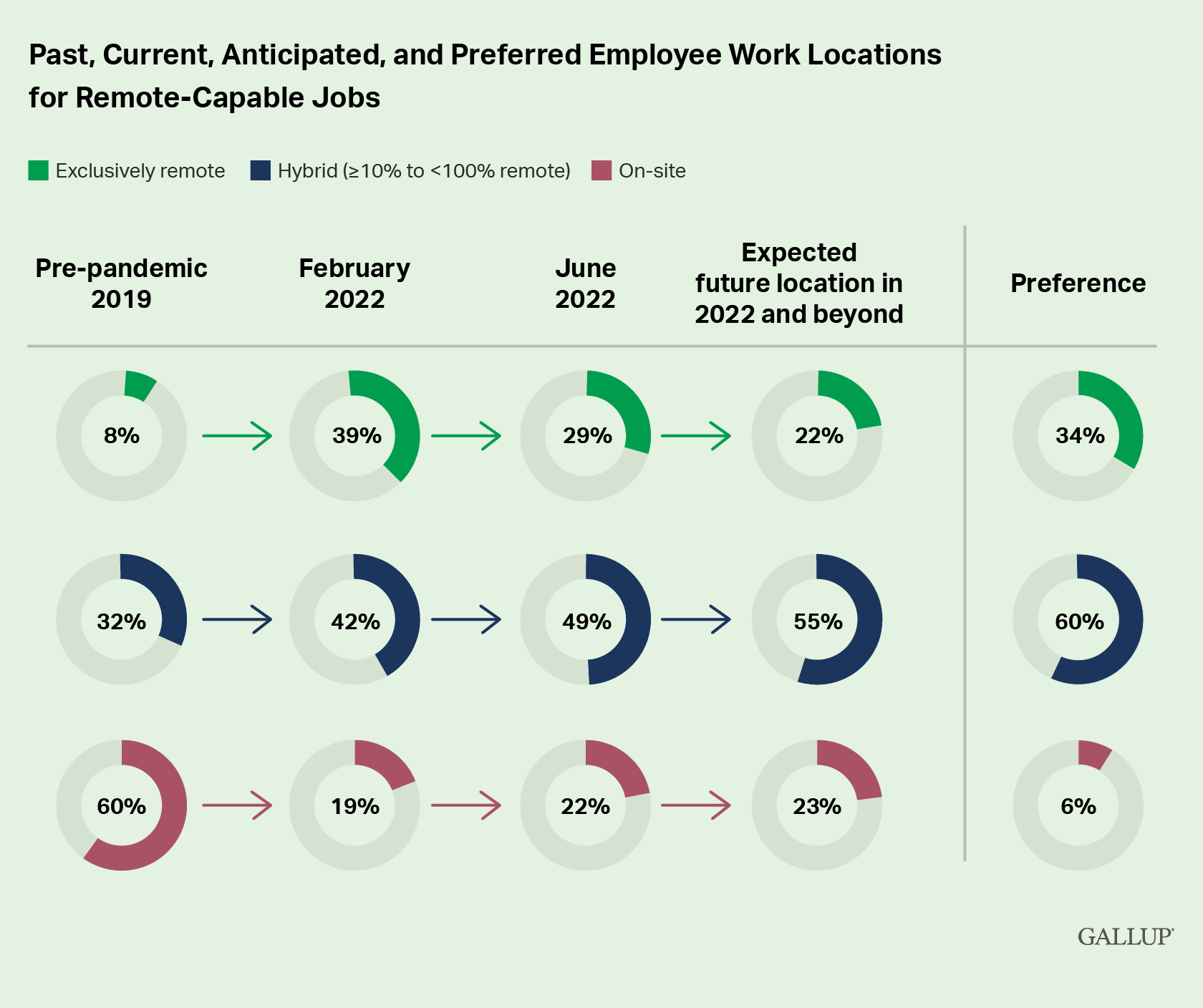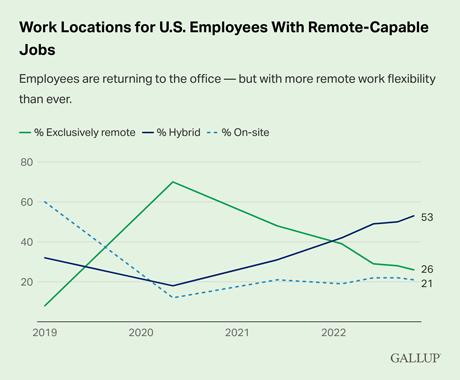Story Highlights
- Gallup estimates 70+ million U.S. workers can do their job working remotely
- Only two in 10 remote-capable employees are currently working fully on-site
- When an employee's location preference doesn't match their current work location, burnout rises while engagement drops
The Situation:
The "Great Global Work-From-Home Experiment" created by the COVID-19 pandemic has changed how we work and expect to work far into the future.
As organizations ease back into office life, employees and employers are navigating a new chapter in this experiment. One that is now blending remote work flexibility and on-site work.
This new chapter is just beginning to write itself as 2022 progresses and more employees return to the office for at least part of their week.
Navigating the journey back to the office and crafting a long-term remote work strategy will require a clear understanding of how organizations are structuring remote work flexibility and what is working best for employees.
Key Questions:
Using a nationally representative sample of 8,090 remote-capable U.S. employees surveyed in June 2022, we explored the following questions:
- How many remote-capable employees are currently working hybrid or fully remote?
- Where do they expect to work long-term and where would they prefer to work?
- What happens when remote-capable employees do not work in their preferred location(s)?
The Findings:
Insight No. 1:
How many remote-capable employees are currently working hybrid or fully remote?
Approximately 56% of full-time employees in the U.S. -- more than 70 million workers -- say their job can be done working remotely from home. We call them "remote-capable employees."
Current work location for remote-capable workers as of June 2022:
- five in 10 are working hybrid (part of their week at home and part on-site)
- three in 10 are exclusively working remotely
- two in 10 are entirely on-site
Insight No. 2:
Where do remote-capable employees expect to work long term and where would they prefer to work?
Hybrid work has increased in 2022 (from 42% in February to 49% in June) and is expected to further increase to 55% of remote-capable workers by the end of 2022 and beyond.
- This shift aligns closely with the preferences of many remote-capable workers, as 60% want a long-term hybrid work arrangement.
Fully remote work arrangements are expected to continue decreasing from three in 10 remote-capable employees in June, down to two in 10 for the long term, despite 34% wanting to permanently work from home.
- Nonetheless, long-term, fully remote work arrangements are expected to nearly triple compared to 2019 figures. Whether this shift satisfies employees with a strong affinity for permanently working from home is yet to be determined.
Fully on-site work is expected to remain a relic of the past with only two in 10 remote-capable employees currently working entirely on-site and about the same number expecting to be entirely on-site in the future -- down from a whopping 60% in 2019.
- A mere 6% want to work entirely on-site going forward. Doesn't it seem that traditional management and workplace practices are broken if more than 90% of 70 million employees say they don't want to come back to the office full time?

Insight No. 3:
What happens when remote-capable employees do not work in their preferred location(s)?
The risk: Employees who don't work in their preferred location have significantly lower employee engagement, alongside higher burnout and desire to quit. They simply do not feel well-positioned to do their best work or live their best life.
Changing expectations from workers who feel stuck on-site: On-site workers whose job is remote capable have an increasing desire for remote flexibility. While the majority (65%) prefer hybrid work; the desire to exclusively WFH has doubled since October of 2021.
The endowment effect: Behavioral economics teaches us that people do not like to give up things they have acquired -- we're loss-averse by nature. Similarly, many employees working hybrid or fully remote have come to expect permanent remote flexibility.
- six in 10 exclusively remote employees are "extremely likely to change companies" if not offered remote flexibility
- three in 10 hybrid employees are "extremely likely to change companies" if not offered remote flexibility
- the demand for long-term remote flexibility has substantially increased since June 2021
What Leaders Should Do Next:
Making the right decisions today, planning for the future, and adapting as you learn requires a firm understanding of your employees' work experiences and how they are changing. We recommend beginning this assessment process by examining your organization's current state of remote work, business needs, and risks so you can more effectively navigate the nuances of your remote and hybrid work strategies.
Follow us for future briefings on what policies and management practices matter most in leading a successful return to the office.
To build a hybrid work strategy:
- Learn more about what makes a solid hybrid work strategy for employees and organizations.
- Contact Gallup to discuss building a culture where hybrid work succeeds.




